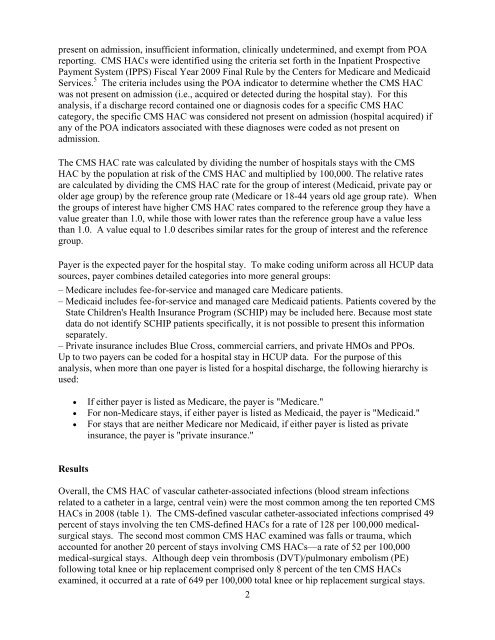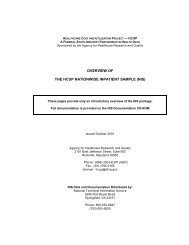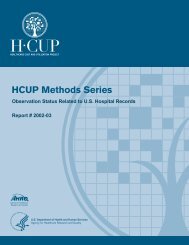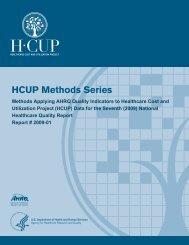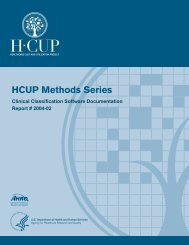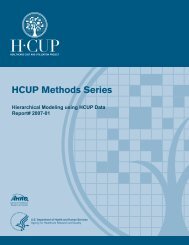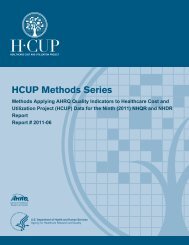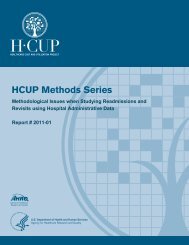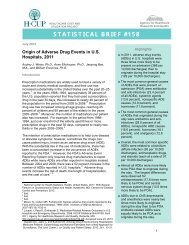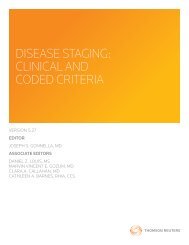An Example of Using Present on Admission Data - HCUP
An Example of Using Present on Admission Data - HCUP
An Example of Using Present on Admission Data - HCUP
You also want an ePaper? Increase the reach of your titles
YUMPU automatically turns print PDFs into web optimized ePapers that Google loves.
present <strong>on</strong> admissi<strong>on</strong>, insufficient informati<strong>on</strong>, clinically undetermined, and exempt from POAreporting. CMS HACs were identified using the criteria set forth in the Inpatient ProspectivePayment System (IPPS) Fiscal Year 2009 Final Rule by the Centers for Medicare and MedicaidServices. 5 The criteria includes using the POA indicator to determine whether the CMS HACwas not present <strong>on</strong> admissi<strong>on</strong> (i.e., acquired or detected during the hospital stay). For thisanalysis, if a discharge record c<strong>on</strong>tained <strong>on</strong>e or diagnosis codes for a specific CMS HACcategory, the specific CMS HAC was c<strong>on</strong>sidered not present <strong>on</strong> admissi<strong>on</strong> (hospital acquired) ifany <str<strong>on</strong>g>of</str<strong>on</strong>g> the POA indicators associated with these diagnoses were coded as not present <strong>on</strong>admissi<strong>on</strong>.The CMS HAC rate was calculated by dividing the number <str<strong>on</strong>g>of</str<strong>on</strong>g> hospitals stays with the CMSHAC by the populati<strong>on</strong> at risk <str<strong>on</strong>g>of</str<strong>on</strong>g> the CMS HAC and multiplied by 100,000. The relative ratesare calculated by dividing the CMS HAC rate for the group <str<strong>on</strong>g>of</str<strong>on</strong>g> interest (Medicaid, private pay orolder age group) by the reference group rate (Medicare or 18-44 years old age group rate). Whenthe groups <str<strong>on</strong>g>of</str<strong>on</strong>g> interest have higher CMS HAC rates compared to the reference group they have avalue greater than 1.0, while those with lower rates than the reference group have a value lessthan 1.0. A value equal to 1.0 describes similar rates for the group <str<strong>on</strong>g>of</str<strong>on</strong>g> interest and the referencegroup.Payer is the expected payer for the hospital stay. To make coding uniform across all <strong>HCUP</strong> datasources, payer combines detailed categories into more general groups:– Medicare includes fee-for-service and managed care Medicare patients.– Medicaid includes fee-for-service and managed care Medicaid patients. Patients covered by theState Children's Health Insurance Program (SCHIP) may be included here. Because most statedata do not identify SCHIP patients specifically, it is not possible to present this informati<strong>on</strong>separately.– Private insurance includes Blue Cross, commercial carriers, and private HMOs and PPOs.Up to two payers can be coded for a hospital stay in <strong>HCUP</strong> data. For the purpose <str<strong>on</strong>g>of</str<strong>on</strong>g> thisanalysis, when more than <strong>on</strong>e payer is listed for a hospital discharge, the following hierarchy isused:• If either payer is listed as Medicare, the payer is "Medicare."• For n<strong>on</strong>-Medicare stays, if either payer is listed as Medicaid, the payer is "Medicaid."• For stays that are neither Medicare nor Medicaid, if either payer is listed as privateinsurance, the payer is "private insurance."ResultsOverall, the CMS HAC <str<strong>on</strong>g>of</str<strong>on</strong>g> vascular catheter-associated infecti<strong>on</strong>s (blood stream infecti<strong>on</strong>srelated to a catheter in a large, central vein) were the most comm<strong>on</strong> am<strong>on</strong>g the ten reported CMSHACs in 2008 (table 1). The CMS-defined vascular catheter-associated infecti<strong>on</strong>s comprised 49percent <str<strong>on</strong>g>of</str<strong>on</strong>g> stays involving the ten CMS-defined HACs for a rate <str<strong>on</strong>g>of</str<strong>on</strong>g> 128 per 100,000 medicalsurgicalstays. The sec<strong>on</strong>d most comm<strong>on</strong> CMS HAC examined was falls or trauma, whichaccounted for another 20 percent <str<strong>on</strong>g>of</str<strong>on</strong>g> stays involving CMS HACs—a rate <str<strong>on</strong>g>of</str<strong>on</strong>g> 52 per 100,000medical-surgical stays. Although deep vein thrombosis (DVT)/pulm<strong>on</strong>ary embolism (PE)following total knee or hip replacement comprised <strong>on</strong>ly 8 percent <str<strong>on</strong>g>of</str<strong>on</strong>g> the ten CMS HACsexamined, it occurred at a rate <str<strong>on</strong>g>of</str<strong>on</strong>g> 649 per 100,000 total knee or hip replacement surgical stays.2


